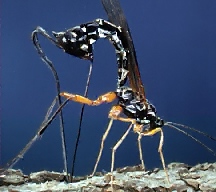This brings us to ichneumonoid wasps. If you thought the reproductive system from the Alien movies was weird, bear in mind that the Xenomorph's way of doin' it was based LARGELY on this particular sort of insect (with later nods to eusociality).
If the earlier entry on botflies did not tip you off, chest-bursters are very, very real in the cruel world of nature. There are a number of ways that they can theoretically happen, but, in the case of ichneumon wasps, they deposit the eggs via a whip.

"If I be waspish, best beware my sting..." Yeah, I'm sure I butchered that Shakespeare quote, but stingers ARE derived from ovipositors. Way to lace an extra innuendo in there, Bard.
The females of Megarhyssa and Rhyssa in particular are equipped with slender, narrow ovipositors (tubes for depositing eggs). Although many insects have ovipositors of some sort, ichneumon wasps have ovipositors that curl over like scorpion tails. This has given them the nickname of "scorpion wasps."
Why does the female need such a long ovipositor? Ichneumonoid wasps lay their eggs inside other insect larvae. The infected larvae are, slowly but surely, eaten alive.

Despite their creepy appearance and alien reproductive habits, these wasps are quite efficient at pest reduction (like the giant hornets are). They also use polydnaviruses to suppress the host's immune response, which is more than can be said for the Xenomorphs.

Just pest control. Nothing personal.



No comments:
Post a Comment